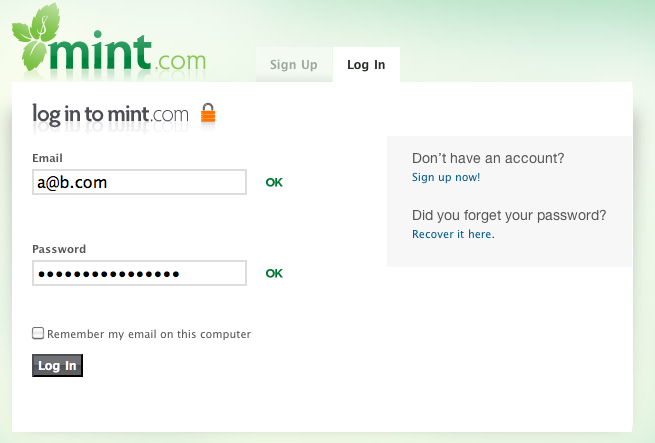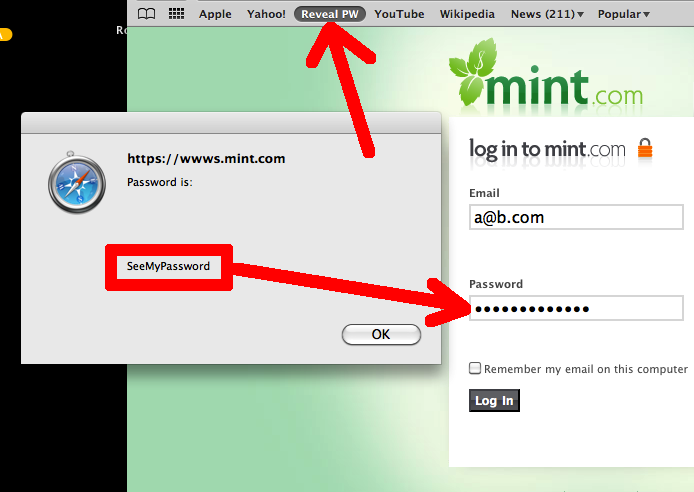You're not stupid, you know you shouldn't store facebook passwords on communal computers just incase you get 'facebook raped', which I believe sounds too crude even to my standards. Before social media, taunting someone that they 'got raped' was a horrific thing to say, now its seems completely acceptable. Facebook is now allowing API's to authenticate though there's no enforced regulations over the internet nor a mutual handshake between facebook and the host presenting the login... Meaning there's nothing stopping me (apart from the ethnic considerations) to construct a quasi interface saying 'log into facebook' though all your doing is giving me your credentials, cheers gullible easy person, time to be 'facebook raped'!
Of course this isn't the biggest problem with storing passwords. Stealing facebook credentials has it's limitations to the realms of changing your 'relationship status' to married or sending hatred messages to people. Seems harmless long-term right? So, ever wondered why it's always recommended NOT to store your passwords on shared computers. Well, here's why.
Communal desktops (such as internet cafes, your workplace, libraries etc) enforce their policies by preventing you to save your credentials with a web interface. This is considered best practice in preventing the related issues though lets imagine our laptop was stolen or you super-paranoid partner who wants to know if you're banging the secretary from your workplace even though you've continuously informed that person your not (even though you are!). Keeping stored passwords on your communal computer allows that criminal or 'love-one' to retrieve the information required.
The issue individuals have is trying to remember all their credentials
- Bank Accounts
- Frequent flyer miles
- Social media (bebo, facebook (or whatever the kids are using these days)
- Pension Schemes
- Online Shopping (amazon, ebay)
- Even things like your fantast football team
As a substitute, individual tend to have a small quantitative amount of passwords (maybe 3-4 different passwords) they use for various purposes. If your password is compromised, this allows individuals the opportunity to access your other accounts easily. E-mails are no exception. Someone gains your e-mail credentials then goes to facebook and click 'forgot password', facebook is assuming that you've forgot your facebook credentials though you can retrieve this though your e-mail account.... oops, thats not right!
Now I've set the scene, lets go back to the reason why you shouldn't store passwords
In this example I have used Mint.com as my reference to discovering password.

Notice my password is quite simply a load of astricks.
Oh, by the way, this is in no way intending to offend the security measures of mint.com. I believe it's one of the safer website even though it contains your bank details. I'm quite simply using a known and credited company as an example.
This example isn't just mint.com, this also be used to hack facebook, bebo, bank accounts, youtube etc.
Note:This has been done in safari though works in other web GUI's
- Start by right clicking on a saved bookmark and click edit Address.

- Within the address add in the following:
javascript:(function(){var%20s,F,j,f,i;%20s%20=%20%22%22;%20F%20=%20document.forms;%20for(j=0;%20j<F.length;
%20++j)%20{%20f%20=%20F[j];%20for%20(i=0;%20i<f.length;%20++i)%20{%20if%20(f[i]
.type.toLowerCase()%20== %20%22password%22)%20s%20+=%20f[i].value%20+%20%22\n%22;%20}%20}%20if%20(s)
%20alert(%22Password%20 is:\n\n%22%20+%20s);%20else%20alert(%22No%20passwords%22);})();

Important: Make sure there are not spaces in this javascript string. I have included spaces to ensure it can fit on this page

- Go back to your website with your stored password and click on the bookmark you just saved your javascript value
- The following window will pop up exposing your password

OMG, look at that, I can see the password that was stored securely (or was it)! It goes without saying that this should be used for personal use only. If you are the recipient of a starker-partner action then don't blame me, I'm not the person dating a crazy person.
About the author
 Daniel is a Technical Manager with over 10 years of consulting expertise in the Identity and Access Management space.
Daniel is a Technical Manager with over 10 years of consulting expertise in the Identity and Access Management space.Daniel has built from scratch this blog as well as technicalconfessions.com
Follow Daniel on twitter @nervouswiggles
Comments
Other Posts
AS I was migrating my environment into an S3 environment, I wanted to leverage off the SES services that AWS provide, more specifically, to leverage the off the SMTP functionality by sending an email via PHP
Read More...
The WeMos D1 is a ESP8266 WiFi based board is an extension to the current out-of-the-box library that comes with the Arduino installation. Because of this, you need to import in the libraries as well as acknowledging the specific board. This process is highly confusion with a number of different individuals talking about a number of different ways to integrate.
Read More...
NameID element must be present as part of the Subject in the Response message, please enable it in the IDP configuration.
Read More...
For what I see, there's not too many supportive documentations out there that will demonstrate how provision AD group membership with the ICF connector using OpenIDM. The use of the special ldapGroups attribute is not explained anywhere in the Integrators guides to to the date of this blog. This quick blog identifies the tasks required to provision AD group membership from OpenIDM to AD using the LDAP ICF connector. However this doesn't really explain what ldapGroups actually does and there's no real worked example of how to go from an Assignment to ldapGroups to an assigned group in AD. I wrote up a wiki article for my own reference: AD group memberships automatically to users This is just my view, others may disagree, but I think the implementation experience could be improved with some more documentation and a more detailed example here.
Read More...
In the past, the similar error occurred though for the Oracle Identity Management solution. invalidcredentialexception remote framework key is invalid Because they all share the ICF connector framework, the error/solution would be the same.
Read More...
org.forgerock.script.exception.ScriptCompilationException: missing ; before statement
Read More...
ForgeRock IDM - org.forgerock.script.exception.ScriptCompilationException: missing ; before statement
Read More...
When performing the attempt of a reconciliation from ForgeRock IDM to Active Directory, I would get the following error
Read More...
In the past, the similar error occurred though for the Oracle Identity Management solution. invalidcredentialexception remote framework key is invalid Because they all share the ICF connector framework, the error/solution would be the same.
Read More...
During the reconcilation from OpenIDM to the ICF google apps connector, the following error response would occur. ERROR Caused by com.google.api.client.auth.oauth2.TokenResponseException 400 Bad Request - invalid_grant
Read More...

